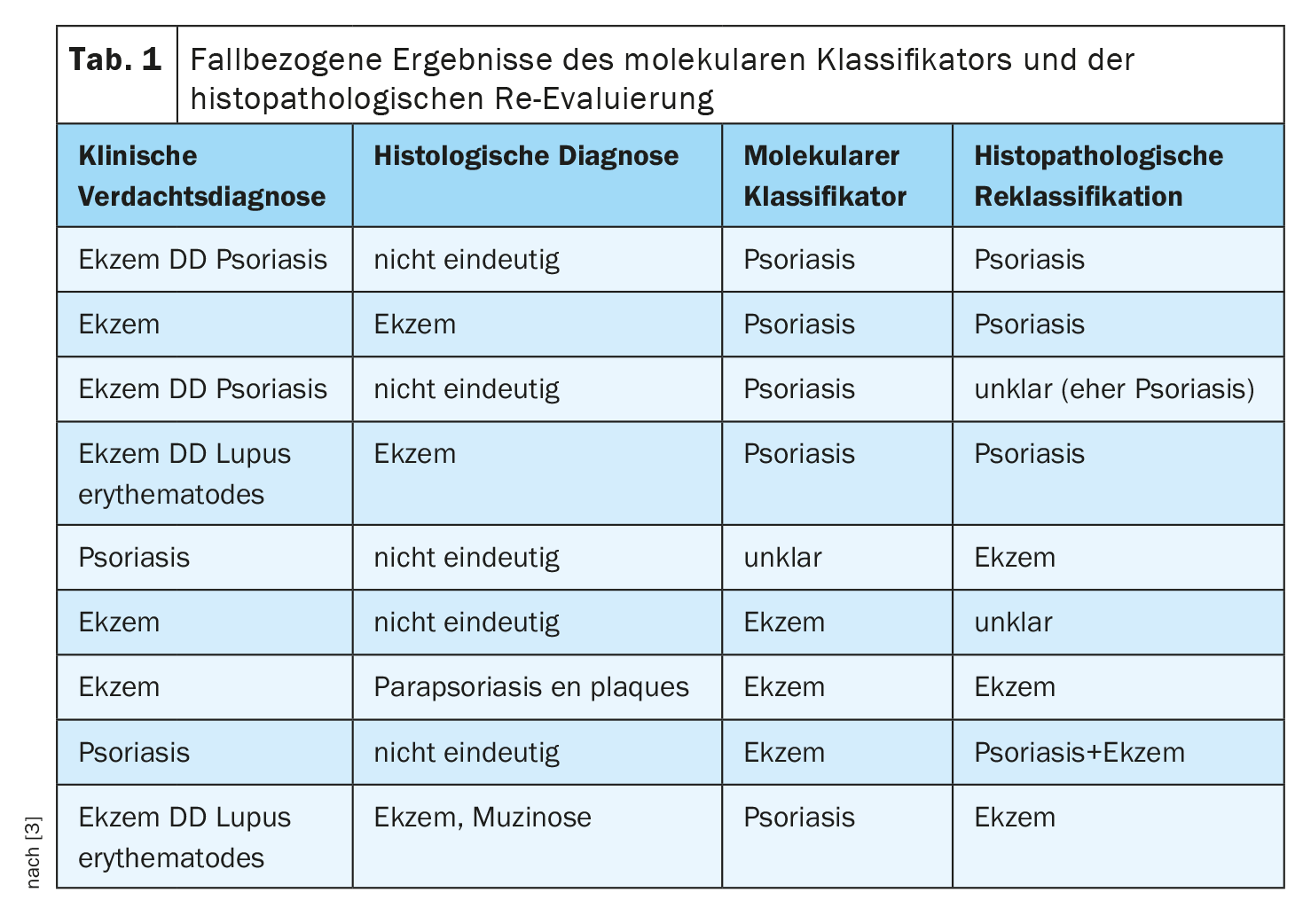In everyday clinical practice, eczema or psoriasis are often diagnosed at a glance. In clinically inconclusive cases, histological examination can provide valuable information, but it is not uncommon for clinically unclear cases to show no clear histological picture. The use of a molecular classifier should help to achieve a more precise diagnosis. Several research projects are currently underway.
Psoriasis palmoplantaris is an important differential diagnosis to hand eczema, but since the clinical picture is often similar and dermatopathohistologic analysis often cannot distinguish between the two diseases, it is sometimes difficult even for experienced clinicians to derive a clear clinical-morphologic diagnosis [1,2]. Although contact sensitization is more frequently associated with chronic hand eczema than with psoriasis, it is not a reliable distinguishing feature [3]. Clinical features such as hyperkeratosis, acanthosis or spongiosis can occur in lesional skin of both diseases [3]. There are also mixed forms (so-called excema in psoriatico) [3]. Correct diagnosis as early as possible is an important basis for the initiation of adequate (systemic) therapy and therefore has implications for the further course of the disease [3]. A few years ago, a molecular classifier was developed with the aim of being able to use a precise diagnostic tool to differentiate between psoriasis and eczema in cases that cannot be clearly differentiated clinically [1,4]. The principle of the method is that the expression of the two genes NOS2 and CCL27 is determined in biopsy material of lesional skin, set in relation to each other and the probability of the presence of eczema or psoriasis is calculated from this [3]. A classifier trained using these genes achieved an average accuracy of around 97% in test cohorts [1,5].
Results from ongoing research projects
There are several case reports showing that molecular diagnostics can positively influence the course of treatment and contribute to the improvement or healing of the clinical picture [1,6]. And since 2020, a cohort of patients with a suspected diagnosis of “palmoplantar psoriasis” or “palmoplantar eczema” has been established in the Occupational Dermatology Section of Heidelberg University Hospital [1]. Partial evaluations after the end of the first project year (n=135) show that the severity according to the Physician Global Assessment (PGA) was classified as moderate in 48.1% of the study participants [1]. In 28.1% and 3.7%, the dermatosis was classified as “severe” and “very severe” respectively and in 20.0% the skin disease was classified as “mild” [1]. In 31.2% of cases, the exact diagnosis remained unclear after clinical examination by the dermatologist. Using the molecular classifier, these doctors received a diagnosis in over 99% of cases [1]. The authors conclude that the initial interim results indicate that the molecular classifier can contribute to an improvement in the diagnostic differentiation of psoriasis vs. eczema in unclear cases [1].
An Austrian occupational dermatology prevention program also documented a case series of patients (n=27) in whom it was not possible to clearly differentiate between eczema and psoriasis after clinical assessment and histological findings [3]. The suspected clinical diagnosis was eczema or psoriasis in 10 of the cases and in 7 patients no clear suspected diagnosis could be made based on the medical history and clinical picture. Although a subsequent histological examination provided valuable diagnostic information, the results were also inconclusive in several cases. In cases in which histology and classifier provided divergent results, a histopathologist performed a new diagnosis (Table 1) [3].
Literature:
- Bentz P, Eyerich K, Weisshaar E: Psoriasis or eczema? One-year results from the DGUV research project FB323 using the molecular classifier for occupational dermatoses. JDDG 2022; https://onlinelibrary.wiley.com/doi/pdf/10.1111/ddg.14850_g,(last accessed 05.12.2023)
- Kolesnik M, et al: Eczema in psoriatico: an important differential diagnosis between chronic allergic contact dermatitis and psoriasis in palmoplantar localization. Acta Derm Venereol 2018; 98(1): 50-58.
- Wilfinger D, et al: Differentiation between chronic hand eczema and psoriasis by a new molecular classifier in an Austrian occupational dermatology patient collective. Dermatology in Occupation and Environment, Volume 71, 1/2023: 1-8.
- Garzorz-Stark N, Eyerich K: Molecular diagnostics of hand eczema. Dermatologist 2019; 70: 760-765.
- Garzorz-Stark N, et al: A novel molecular disease classifier for psoriasis and eczema. Exp Dermatol 2016; 25(10): 767-767
- Weisshaar E, Garzorz-Stark N, Eyerich K: Eczema or psoriasis? A special challenge in occupational dermatology. Dermatology in Occupation and Environment 2018; 66: 113-119.
DERMATOLOGY PRACTICE 2023: 33(6): 40












